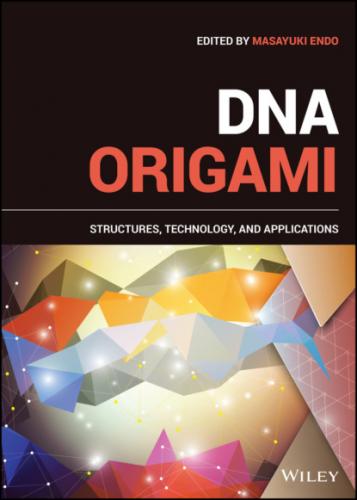Source: Gerling et al. [100]/with permission of American Association for the Advancement of Science.
(c) A rotatable DNA origami structure. Two plates can rotate on the central axis. A locked state and a relaxed state are formed by addition and removal of specific DNA strands. Left‐handed and right‐handed form can be controlled by a DNA strand exchange reaction. Due to the plasmonic interaction between AuNRs and chirality, locked and relaxed state are detected by CD spectra.
Source: Kuzyk et al. [101]/Springer Nature/CC BY 4.0.
(d) A plasmonic structure that combines AuNRs that open and close in response to photoirradiation. Repeated ON/OFF of the CD signals is monitored by alternative visible and UV irradiation.
Source: Kuzyk et al. [101]/Springer Nature/CC BY 4.0.
1.12 Conjugation of DNA Origami to Lipid
1.12.1 DNA Origami Channel with Gating
Robust 3D DNA origami can be used for the construction of artificial channels. Channels in the cell membrane transfer specific molecules and ions with a controlled gate system. DNA origami transmembrane channels were created and incorporated into the lipid bilayer [103]. This architecture consists of a robust cylinder‐like structure with a hollow interior and a short tubular pore that penetrates the lipid membrane (Figure 1.14a). To tightly attach to the lipid bilayer surface, multiple cholesterol molecules were incorporated at the bottom of the main body of the channel structure (Figure 1.14b). Using single‐channel electrophysiological measurements, the response of the origami channel showed properties similar to those of the natural ion channels in terms of conductance and channel gating. Using this channel, different lengths of single‐stranded DNAs with a stopper such as a stem and G‐quadruplex were discriminated by electrophysiological measurements. These results show that the origami channels can be further used to identify target molecules by detecting single‐molecule translocation.
1.12.2 DNA Origami Templated Synthesis of Liposomes
DNA nanostructures provide various scaffolds to place size‐controlled materials. Artificial liposomes are a useful tool for studying membrane structures and for applications such as drug delivery. However, it is difficult to control the size of liposomes in a customized fashion. Lin and coworkers created a method for producing sub‐100 nm‐sized liposomes using a DNA origami template (Figure 1.14c,d) [104]. Ring‐shaped DNA origami structures with different diameters were designed and prepared. Lipid molecules were placed via hybridization of the DNA–lipid conjugate onto the inner surface of the DNA ring. Then, the ring with handles was mixed with additional lipid and detergent and dialyzed to induce liposome formation. Liposomes were released from the ring and showed greater uniformity than those prepared using traditional methods. The liposomes produced by this method have a narrow size distribution, indicating that this method can be used to guide lipid bilayer formation. Furthermore, more complex structures of liposomes such as tubular and circular were created using DNA origami cages [105].
1.13 DNA Origami for Biological Applications
DNA origami technology has great potential for various biological applications and has already been extended to cellular studies. DNA nanostructures that are resistant to various types of endo‐ and exonucleases have been reported [106]. DNA origami constructs were able to maintain their structures without degradation or damage in cell lysates of a number of cell lines [107]. The relatively high stability of DNA nanostructures in biological systems and the favorable compatibility with functional biomolecules such as proteins and aptamers show that DNA origami is a promising biomaterial for the investigation of live cell analysis and platforms for safe drug delivery.
1.13.1 Introduction of DNA Origami into Cells and Functional Expression
New drug carrier and delivery systems have been investigated using DNA origami structures. Initially, a fluorescence‐labeled DNA origami was added to cultured cells, and the efficiency of cellular uptake was investigated. Ding and coworkers created a DNA origami structure as a drug carrier containing the anticancer drug doxorubicin (Dox) (Figure 1.15a) [108]. The DNA origami structures carrying a high concentration of drug were efficiently incorporated into cells, and remarkable cytotoxicity was observed. Furthermore, delivery using DNA origami is being studied for living organisms. DNA origami has been used to investigate tumor targeting in mice and drug persistence at the tumor site [112]. DNA origami showed tumor‐specific accumulation, and by introducing the anticancer drug Dox into the DNA origami structure, it showed delivery to the tumor and a remarkable antitumor effect.
Figure 1.14 (a) DNA origami channel structure. Tubular pores (dark gray), main body (light gray), cholesterol moieties (gray) at the bottom of the main body, and TEM image. (b) The DNA channel is bound to the lipid bilayer membrane via cholesterol, and the pore domain penetrates the lipid membrane. TEM image of origami channels bound to a liposome.
Source: Langecker et al. [103]/with permission of Springer Nature.
(c) Precise control of liposome size using DNA origami templates. DNA‐DOPE conjugates were placed inside the ring via hybridization, then extra lipid was supplied, and the formed vesicle was dialyzed. Finally, the size‐controlled liposome was released from the ring template. (d) TEM images of size‐controlled liposomes.
Source: Yang et al. [104]/with permission of Springer Nature.
Figure 1.15 Delivery of DNA origami structures to cells and functional control. (a) The prepared DNA origami structure is intercalated with the anticancer drug doxorubicin (Dox) and introduced into the cells.
Source: Jiang et al. [108]/with permission of American Chemical Society.
(b) Control the binding amount and release rate of Dox using DNA origami structures with different pitches (10.5 and 12 base pairs).
Source: Zhao et al. [109].
(c) Retention of DNA nanodevice in mouse (after two hours). Left: No coating. Accumulated in the bladder. Right: With coating. Distributed throughout the body.
Source: Perrault and Shih [110].
(d) Coating of the structure with PEG‐conjugated cationic polymer (polylysine K10‐PEG5K).
Source: Ponnuswamy et al. [111]/Springer Nature/CC BY 4.0.
In addition, tumor growth was suppressed by incorporating siRNA into the DNA origami structure [113]. A DNA origami structure carrying Bcl2 siRNA that suppresses apoptosis was prepared and introduced into the host cells. Using this structure, Bcl2 expression was suppressed
